Comprehensive Report on Accounting and Finance for Business
VerifiedAdded on 2023/06/18
|21
|2478
|307
Report
AI Summary
This report provides a comprehensive analysis of accounting and finance for a business, covering various aspects such as the calculation of retained earnings, preparation of the statement of financial performance and cash flows, and journal entries for tax payable. It includes detailed calculations of total inventory purchases, cash paid to suppliers, total cash receipts, and closing accounts receivable. The report also computes and analyzes financial ratios like gross profit margin, net profit margin, return on assets, and debt ratio, offering insights into the company's financial health. Furthermore, it calculates net working capital, cash cycle, and constructs a monthly cash budget. The analysis extends to contribution margin, break-even point, and net present value at different interest rates, providing recommendations for strategic initiatives. Finally, the report evaluates the accounting rate of return and payback period for investment decisions.

Accounting and Finance for
Business
Business
Paraphrase This Document
Need a fresh take? Get an instant paraphrase of this document with our AI Paraphraser
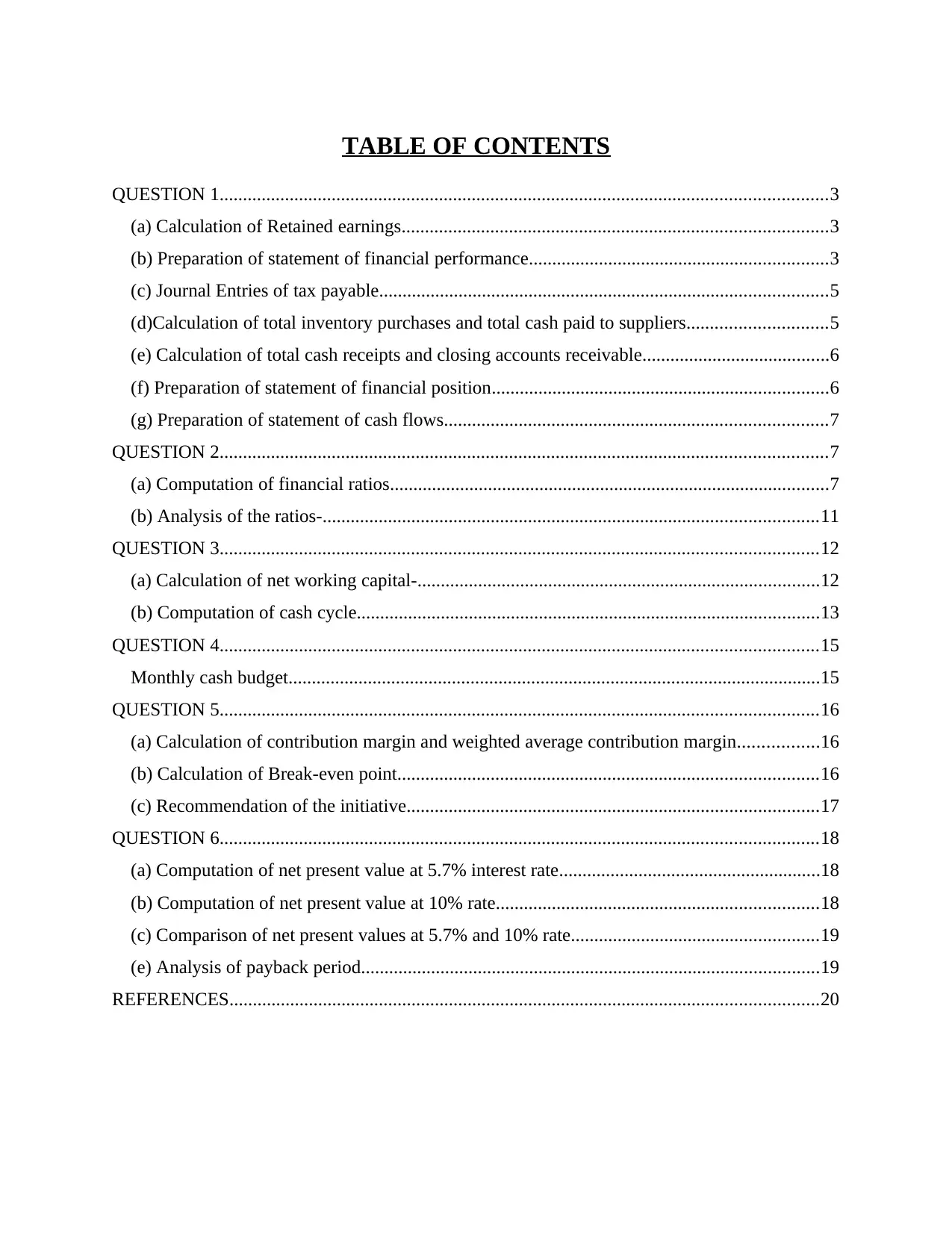
TABLE OF CONTENTS
QUESTION 1..................................................................................................................................3
(a) Calculation of Retained earnings...........................................................................................3
(b) Preparation of statement of financial performance................................................................3
(c) Journal Entries of tax payable................................................................................................5
(d)Calculation of total inventory purchases and total cash paid to suppliers..............................5
(e) Calculation of total cash receipts and closing accounts receivable........................................6
(f) Preparation of statement of financial position........................................................................6
(g) Preparation of statement of cash flows..................................................................................7
QUESTION 2..................................................................................................................................7
(a) Computation of financial ratios..............................................................................................7
(b) Analysis of the ratios-..........................................................................................................11
QUESTION 3................................................................................................................................12
(a) Calculation of net working capital-......................................................................................12
(b) Computation of cash cycle...................................................................................................13
QUESTION 4................................................................................................................................15
Monthly cash budget..................................................................................................................15
QUESTION 5................................................................................................................................16
(a) Calculation of contribution margin and weighted average contribution margin.................16
(b) Calculation of Break-even point..........................................................................................16
(c) Recommendation of the initiative........................................................................................17
QUESTION 6................................................................................................................................18
(a) Computation of net present value at 5.7% interest rate........................................................18
(b) Computation of net present value at 10% rate.....................................................................18
(c) Comparison of net present values at 5.7% and 10% rate.....................................................19
(e) Analysis of payback period..................................................................................................19
REFERENCES..............................................................................................................................20
QUESTION 1..................................................................................................................................3
(a) Calculation of Retained earnings...........................................................................................3
(b) Preparation of statement of financial performance................................................................3
(c) Journal Entries of tax payable................................................................................................5
(d)Calculation of total inventory purchases and total cash paid to suppliers..............................5
(e) Calculation of total cash receipts and closing accounts receivable........................................6
(f) Preparation of statement of financial position........................................................................6
(g) Preparation of statement of cash flows..................................................................................7
QUESTION 2..................................................................................................................................7
(a) Computation of financial ratios..............................................................................................7
(b) Analysis of the ratios-..........................................................................................................11
QUESTION 3................................................................................................................................12
(a) Calculation of net working capital-......................................................................................12
(b) Computation of cash cycle...................................................................................................13
QUESTION 4................................................................................................................................15
Monthly cash budget..................................................................................................................15
QUESTION 5................................................................................................................................16
(a) Calculation of contribution margin and weighted average contribution margin.................16
(b) Calculation of Break-even point..........................................................................................16
(c) Recommendation of the initiative........................................................................................17
QUESTION 6................................................................................................................................18
(a) Computation of net present value at 5.7% interest rate........................................................18
(b) Computation of net present value at 10% rate.....................................................................18
(c) Comparison of net present values at 5.7% and 10% rate.....................................................19
(e) Analysis of payback period..................................................................................................19
REFERENCES..............................................................................................................................20

QUESTION 1.
(a) Calculation of Retained earnings
current assets current liabilities
cash 6 suppler account payable 12
inventory 21 taxes payable 2
accounts receivable 15
prepaid lease 2
non current assets non current liabilities
ppe 60 interest on bank loan 58
accumulated
depreciation 25
equity
contributed capital 10
retained earnings 47
129 129
(b) Preparation of statement of financial performance
Statement of
financial
performance
Sales 208000
-cost of
goods sold 88000
(a) Calculation of Retained earnings
current assets current liabilities
cash 6 suppler account payable 12
inventory 21 taxes payable 2
accounts receivable 15
prepaid lease 2
non current assets non current liabilities
ppe 60 interest on bank loan 58
accumulated
depreciation 25
equity
contributed capital 10
retained earnings 47
129 129
(b) Preparation of statement of financial performance
Statement of
financial
performance
Sales 208000
-cost of
goods sold 88000
⊘ This is a preview!⊘
Do you want full access?
Subscribe today to unlock all pages.

Trusted by 1+ million students worldwide
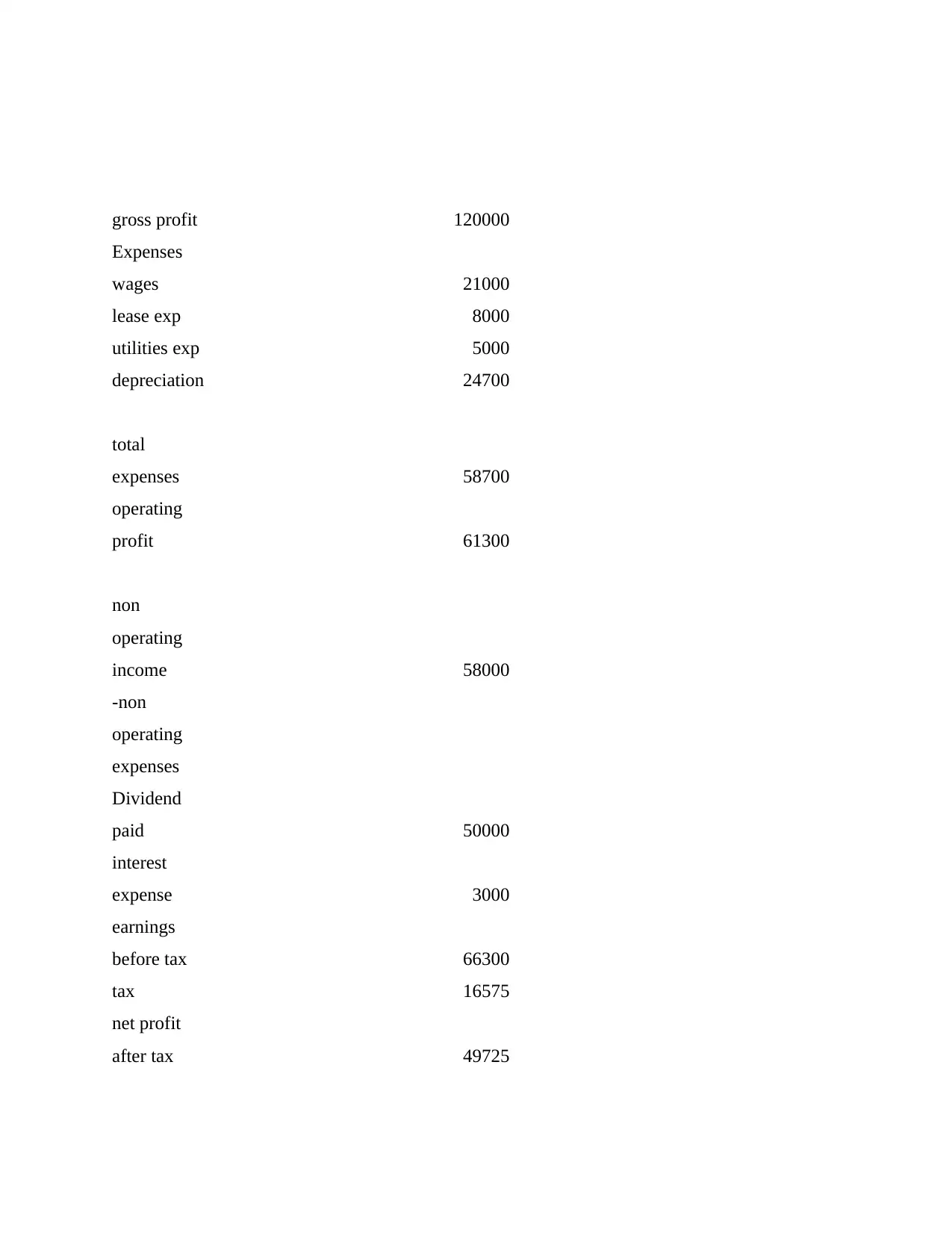
gross profit 120000
Expenses
wages 21000
lease exp 8000
utilities exp 5000
depreciation 24700
total
expenses 58700
operating
profit 61300
non
operating
income 58000
-non
operating
expenses
Dividend
paid 50000
interest
expense 3000
earnings
before tax 66300
tax 16575
net profit
after tax 49725
Expenses
wages 21000
lease exp 8000
utilities exp 5000
depreciation 24700
total
expenses 58700
operating
profit 61300
non
operating
income 58000
-non
operating
expenses
Dividend
paid 50000
interest
expense 3000
earnings
before tax 66300
tax 16575
net profit
after tax 49725
Paraphrase This Document
Need a fresh take? Get an instant paraphrase of this document with our AI Paraphraser
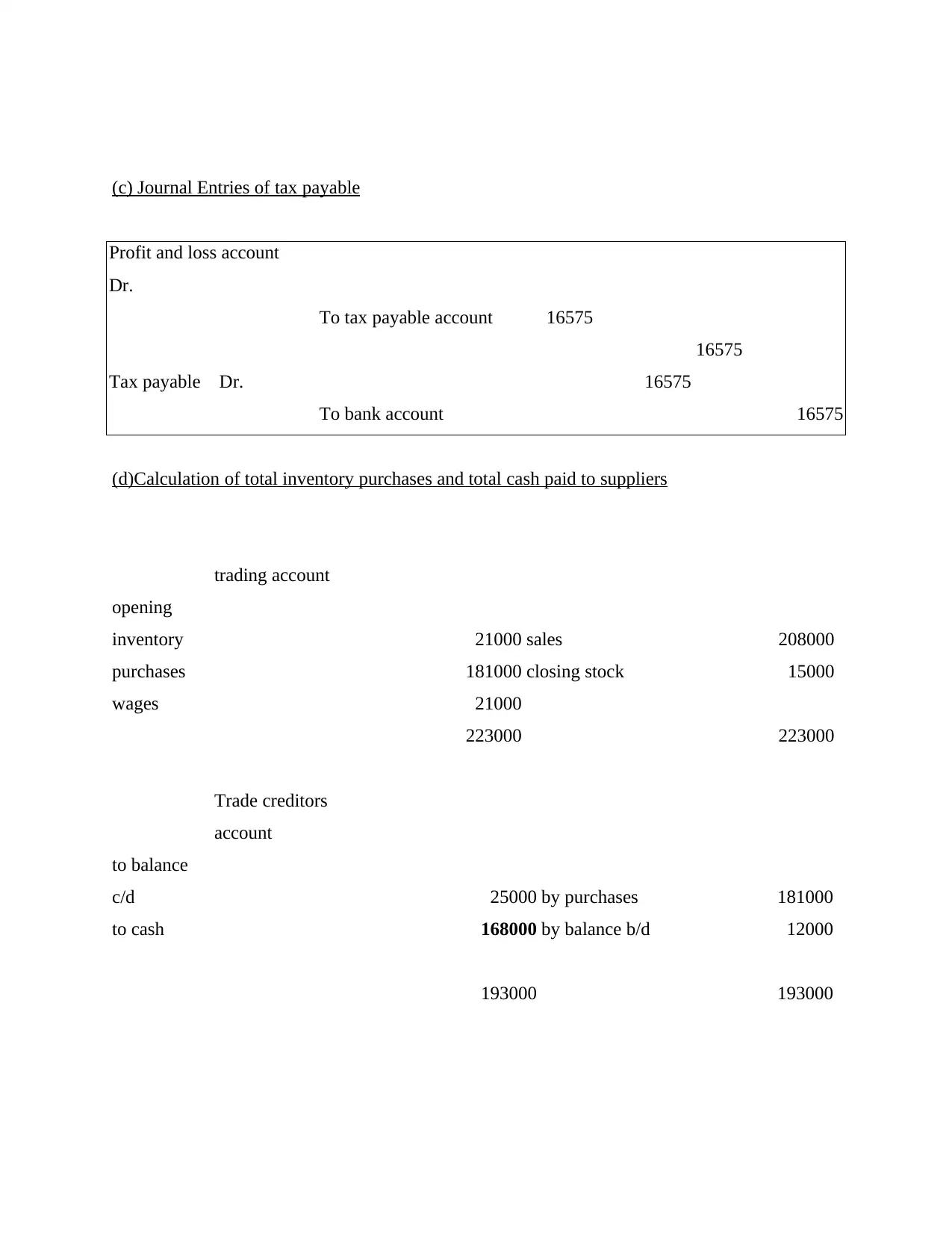
(c) Journal Entries of tax payable
Profit and loss account
Dr.
To tax payable account 16575
16575
Tax payable Dr. 16575
To bank account 16575
(d)Calculation of total inventory purchases and total cash paid to suppliers
trading account
opening
inventory 21000 sales 208000
purchases 181000 closing stock 15000
wages 21000
223000 223000
Trade creditors
account
to balance
c/d 25000 by purchases 181000
to cash 168000 by balance b/d 12000
193000 193000
Profit and loss account
Dr.
To tax payable account 16575
16575
Tax payable Dr. 16575
To bank account 16575
(d)Calculation of total inventory purchases and total cash paid to suppliers
trading account
opening
inventory 21000 sales 208000
purchases 181000 closing stock 15000
wages 21000
223000 223000
Trade creditors
account
to balance
c/d 25000 by purchases 181000
to cash 168000 by balance b/d 12000
193000 193000
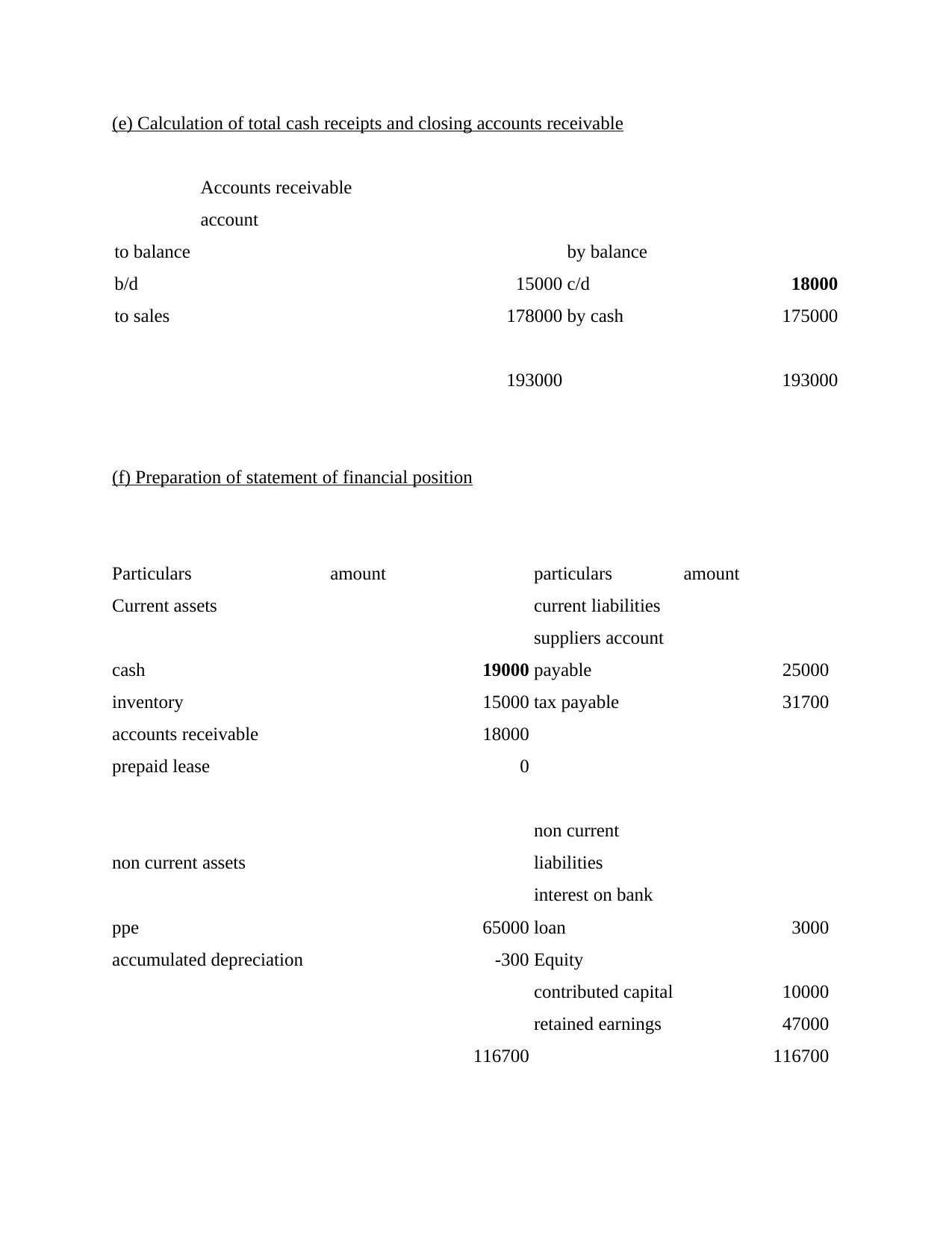
(e) Calculation of total cash receipts and closing accounts receivable
Accounts receivable
account
to balance
b/d 15000
by balance
c/d 18000
to sales 178000 by cash 175000
193000 193000
(f) Preparation of statement of financial position
Particulars amount particulars amount
Current assets current liabilities
cash 19000
suppliers account
payable 25000
inventory 15000 tax payable 31700
accounts receivable 18000
prepaid lease 0
non current assets
non current
liabilities
ppe 65000
interest on bank
loan 3000
accumulated depreciation -300 Equity
contributed capital 10000
retained earnings 47000
116700 116700
Accounts receivable
account
to balance
b/d 15000
by balance
c/d 18000
to sales 178000 by cash 175000
193000 193000
(f) Preparation of statement of financial position
Particulars amount particulars amount
Current assets current liabilities
cash 19000
suppliers account
payable 25000
inventory 15000 tax payable 31700
accounts receivable 18000
prepaid lease 0
non current assets
non current
liabilities
ppe 65000
interest on bank
loan 3000
accumulated depreciation -300 Equity
contributed capital 10000
retained earnings 47000
116700 116700
⊘ This is a preview!⊘
Do you want full access?
Subscribe today to unlock all pages.

Trusted by 1+ million students worldwide
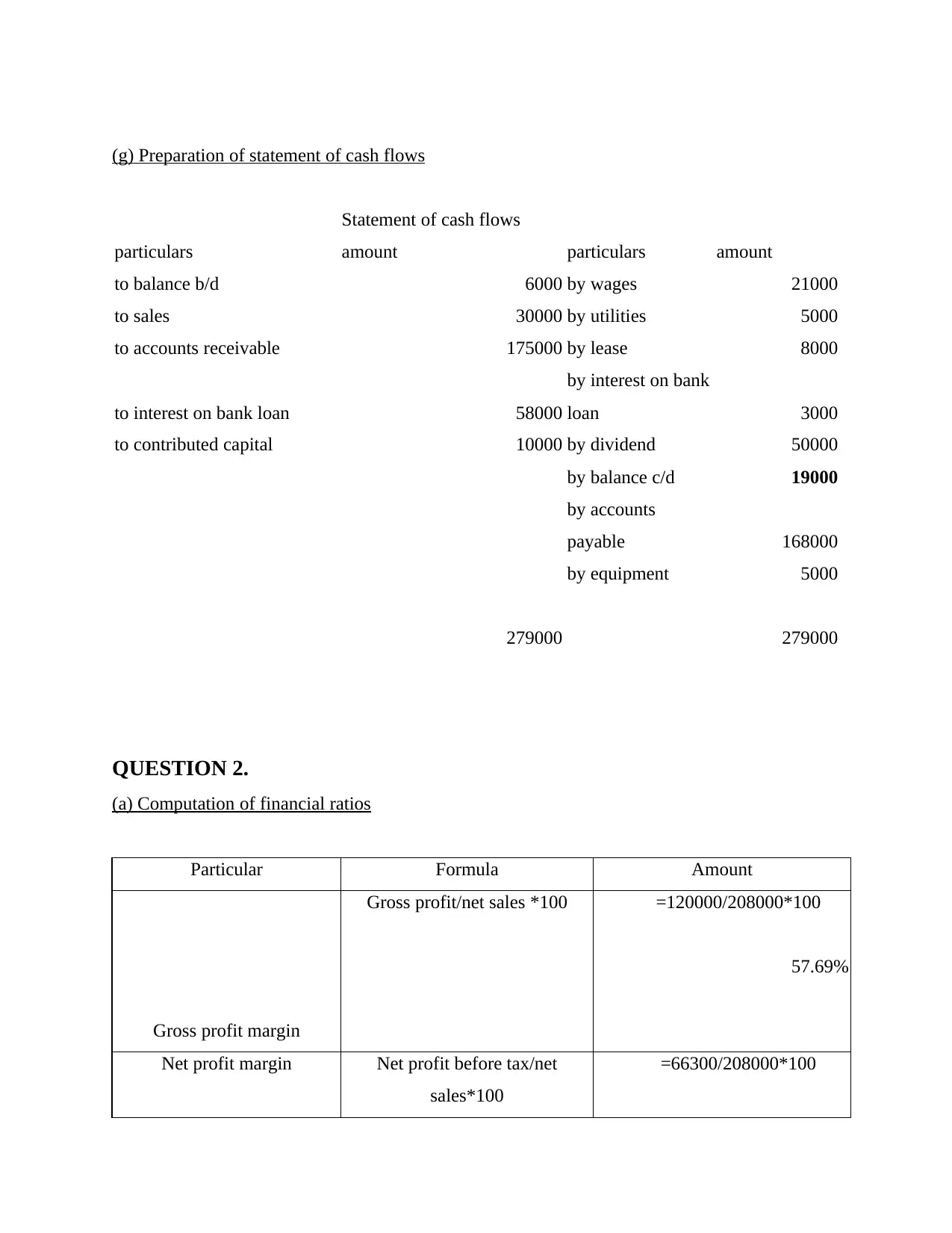
(g) Preparation of statement of cash flows
Statement of cash flows
particulars amount particulars amount
to balance b/d 6000 by wages 21000
to sales 30000 by utilities 5000
to accounts receivable 175000 by lease 8000
to interest on bank loan 58000
by interest on bank
loan 3000
to contributed capital 10000 by dividend 50000
by balance c/d 19000
by accounts
payable 168000
by equipment 5000
279000 279000
QUESTION 2.
(a) Computation of financial ratios
Particular Formula Amount
Gross profit margin
Gross profit/net sales *100 =120000/208000*100
57.69%
Net profit margin Net profit before tax/net
sales*100
=66300/208000*100
Statement of cash flows
particulars amount particulars amount
to balance b/d 6000 by wages 21000
to sales 30000 by utilities 5000
to accounts receivable 175000 by lease 8000
to interest on bank loan 58000
by interest on bank
loan 3000
to contributed capital 10000 by dividend 50000
by balance c/d 19000
by accounts
payable 168000
by equipment 5000
279000 279000
QUESTION 2.
(a) Computation of financial ratios
Particular Formula Amount
Gross profit margin
Gross profit/net sales *100 =120000/208000*100
57.69%
Net profit margin Net profit before tax/net
sales*100
=66300/208000*100
Paraphrase This Document
Need a fresh take? Get an instant paraphrase of this document with our AI Paraphraser
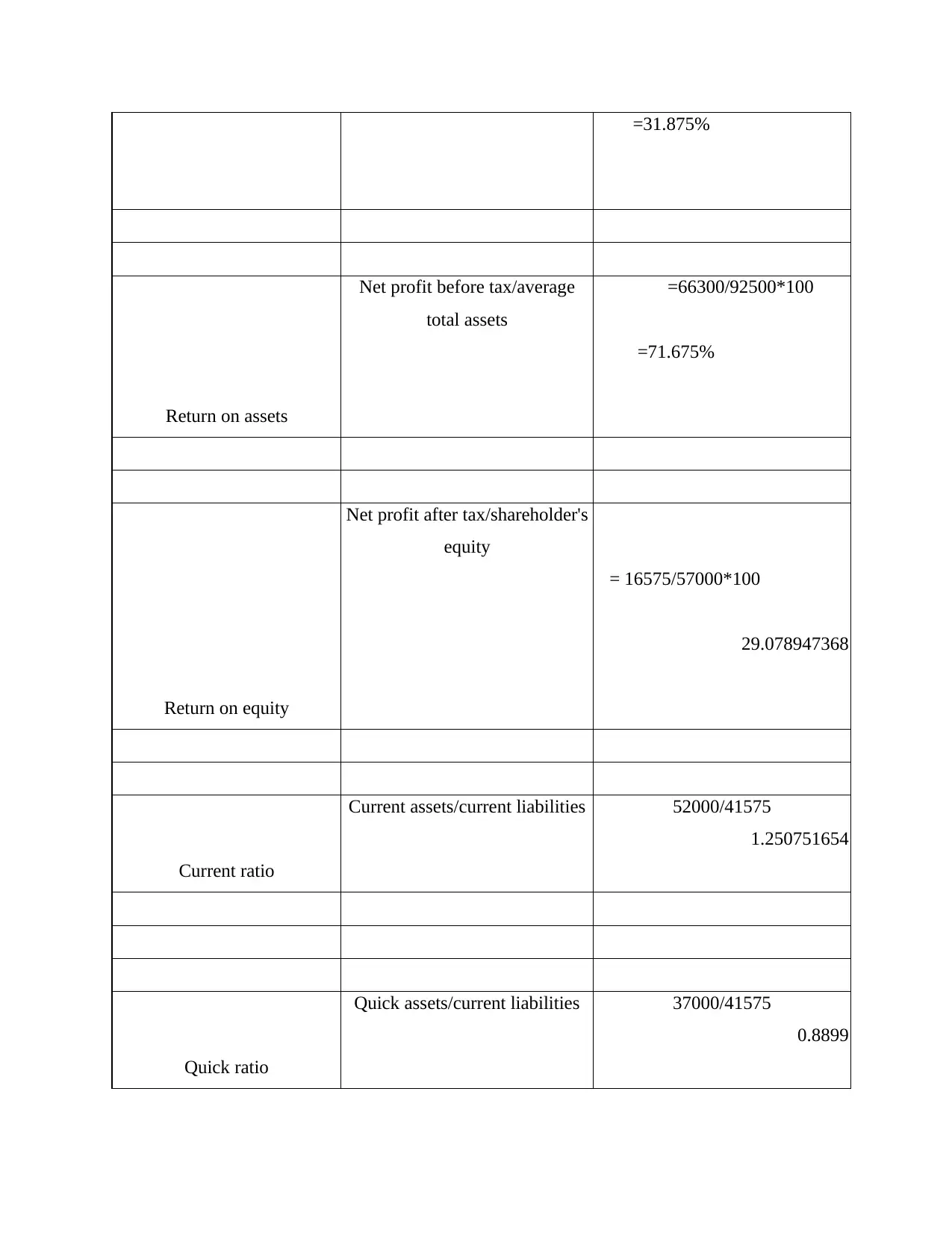
=31.875%
Return on assets
Net profit before tax/average
total assets
=66300/92500*100
=71.675%
Return on equity
Net profit after tax/shareholder's
equity
= 16575/57000*100
29.078947368
Current ratio
Current assets/current liabilities 52000/41575
1.250751654
Quick ratio
Quick assets/current liabilities 37000/41575
0.8899
Return on assets
Net profit before tax/average
total assets
=66300/92500*100
=71.675%
Return on equity
Net profit after tax/shareholder's
equity
= 16575/57000*100
29.078947368
Current ratio
Current assets/current liabilities 52000/41575
1.250751654
Quick ratio
Quick assets/current liabilities 37000/41575
0.8899
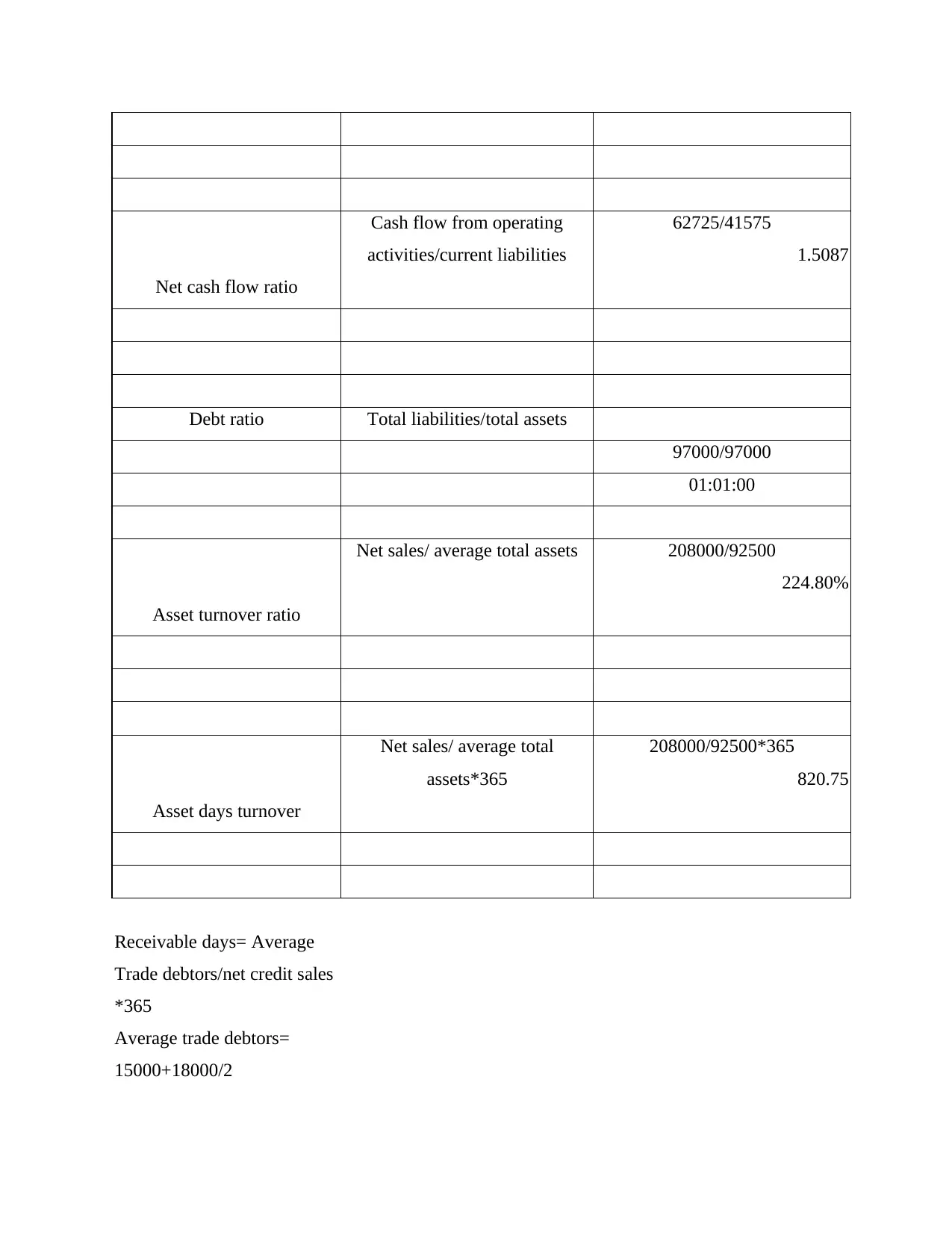
Net cash flow ratio
Cash flow from operating
activities/current liabilities
62725/41575
1.5087
Debt ratio Total liabilities/total assets
97000/97000
01:01:00
Asset turnover ratio
Net sales/ average total assets 208000/92500
224.80%
Asset days turnover
Net sales/ average total
assets*365
208000/92500*365
820.75
Receivable days= Average
Trade debtors/net credit sales
*365
Average trade debtors=
15000+18000/2
Cash flow from operating
activities/current liabilities
62725/41575
1.5087
Debt ratio Total liabilities/total assets
97000/97000
01:01:00
Asset turnover ratio
Net sales/ average total assets 208000/92500
224.80%
Asset days turnover
Net sales/ average total
assets*365
208000/92500*365
820.75
Receivable days= Average
Trade debtors/net credit sales
*365
Average trade debtors=
15000+18000/2
⊘ This is a preview!⊘
Do you want full access?
Subscribe today to unlock all pages.

Trusted by 1+ million students worldwide
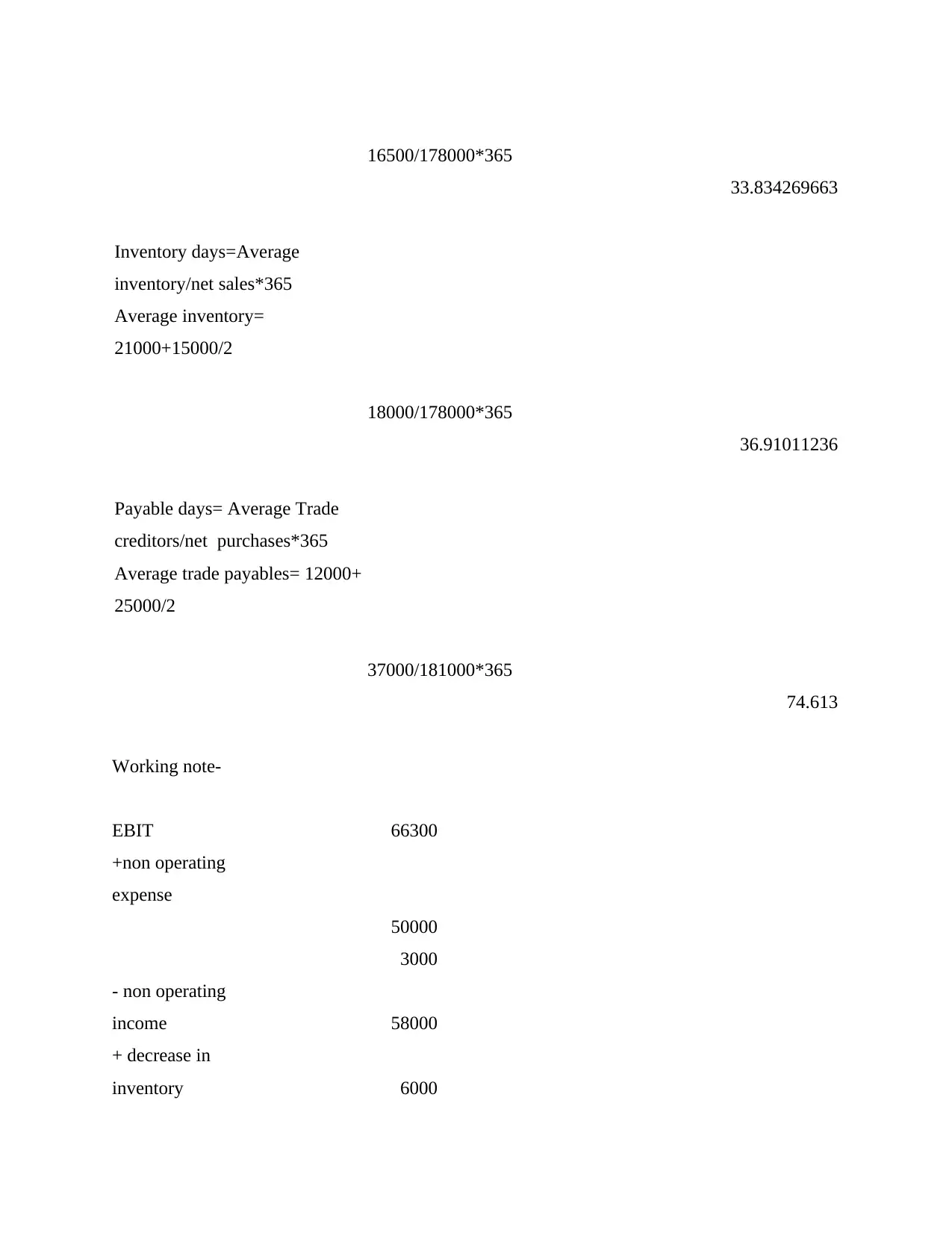
16500/178000*365
33.834269663
Inventory days=Average
inventory/net sales*365
Average inventory=
21000+15000/2
18000/178000*365
36.91011236
Payable days= Average Trade
creditors/net purchases*365
Average trade payables= 12000+
25000/2
37000/181000*365
74.613
Working note-
EBIT 66300
+non operating
expense
50000
3000
- non operating
income 58000
+ decrease in
inventory 6000
33.834269663
Inventory days=Average
inventory/net sales*365
Average inventory=
21000+15000/2
18000/178000*365
36.91011236
Payable days= Average Trade
creditors/net purchases*365
Average trade payables= 12000+
25000/2
37000/181000*365
74.613
Working note-
EBIT 66300
+non operating
expense
50000
3000
- non operating
income 58000
+ decrease in
inventory 6000
Paraphrase This Document
Need a fresh take? Get an instant paraphrase of this document with our AI Paraphraser

- decrease in
accounts
receivable -3000
+ decrease in
prepaid
expenses 2000
+increase in
accounts
payable 13000
-tax paid -16575
62725
(b) Analysis of the ratios-
The ideal gross profit ratio is 65%. Therefore, the company's current gross profit ratio is
below average or bad and the net profit ratio is very good as it has exceeded 20%. In order to
increase the gross profit ratio, the owner should try to reduce the direct costs of the goods. The
liquidity position of the business is good as the current ratio is greater than 1 (Sutarno and et.al.,
2019). The debt ratio is also good but the asset turnover ratio is average as the good asset
turnover ratio is above 2.5. In order to increase it, the obsolete or unused assets should be
liquidated quickly. The company has good cash flow from operating activities as it is greater
than 1. The company's return on assets and return on equity is very good as the average ratio lies
between 5% to 20%. This shows that assets are efficiently contributing to rising profits and
company is generating high profits without using much equity or capital.
Overall, the position of the firm is good as all the ratios are either good or average. Some
of the key areas which should be brought into attention or investigation by the business owner
are the direct costs such as wages, lease expenses, utilities expenses etc. should be reduced. The
ideal assets of the business should be liquidated in order to increase the cash flow position
(Mostafa, Montemagno and Qureshi, 2018).
QUESTION 3.
(a) Calculation of net working capital-
Working note-
accounts
receivable -3000
+ decrease in
prepaid
expenses 2000
+increase in
accounts
payable 13000
-tax paid -16575
62725
(b) Analysis of the ratios-
The ideal gross profit ratio is 65%. Therefore, the company's current gross profit ratio is
below average or bad and the net profit ratio is very good as it has exceeded 20%. In order to
increase the gross profit ratio, the owner should try to reduce the direct costs of the goods. The
liquidity position of the business is good as the current ratio is greater than 1 (Sutarno and et.al.,
2019). The debt ratio is also good but the asset turnover ratio is average as the good asset
turnover ratio is above 2.5. In order to increase it, the obsolete or unused assets should be
liquidated quickly. The company has good cash flow from operating activities as it is greater
than 1. The company's return on assets and return on equity is very good as the average ratio lies
between 5% to 20%. This shows that assets are efficiently contributing to rising profits and
company is generating high profits without using much equity or capital.
Overall, the position of the firm is good as all the ratios are either good or average. Some
of the key areas which should be brought into attention or investigation by the business owner
are the direct costs such as wages, lease expenses, utilities expenses etc. should be reduced. The
ideal assets of the business should be liquidated in order to increase the cash flow position
(Mostafa, Montemagno and Qureshi, 2018).
QUESTION 3.
(a) Calculation of net working capital-
Working note-
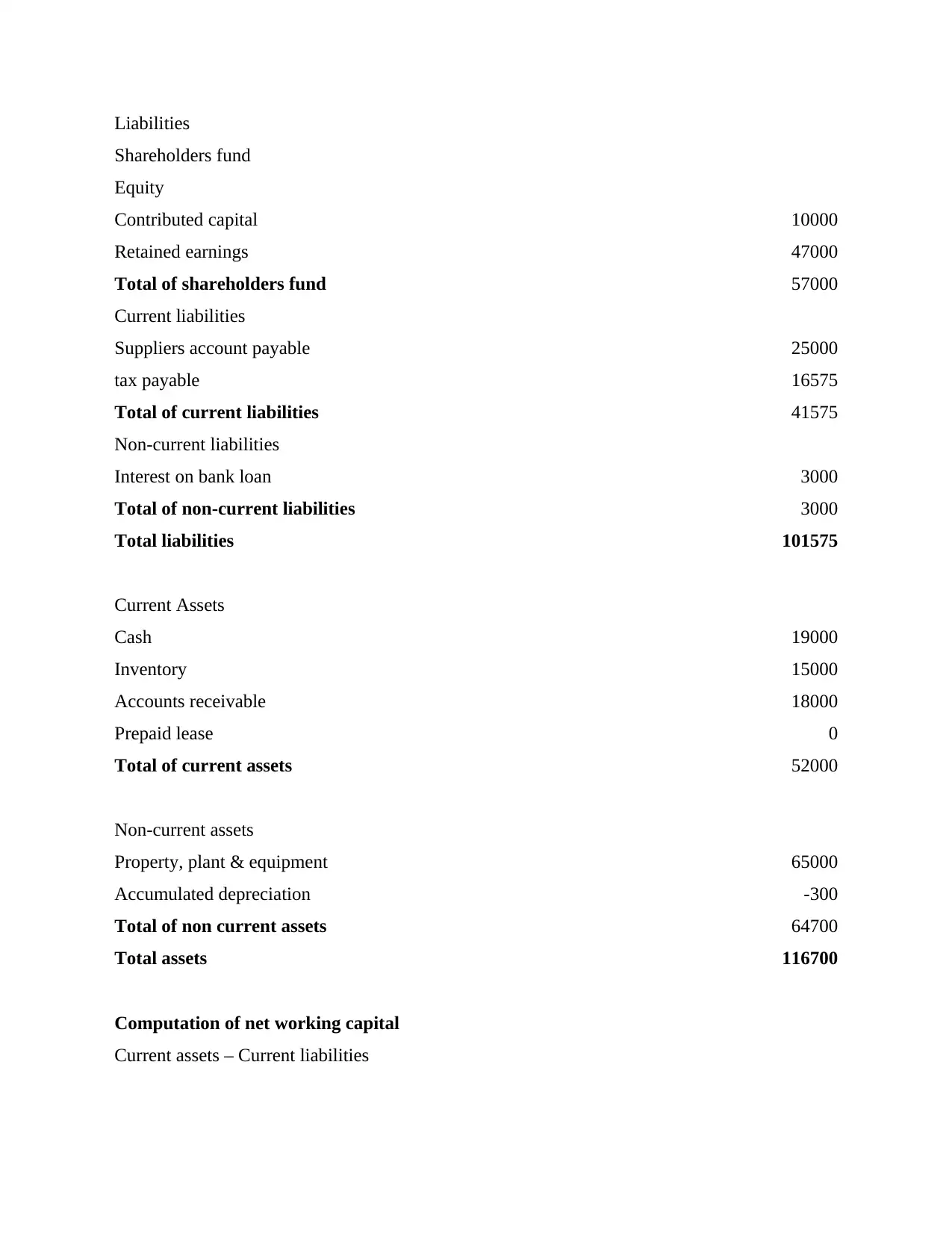
Liabilities
Shareholders fund
Equity
Contributed capital 10000
Retained earnings 47000
Total of shareholders fund 57000
Current liabilities
Suppliers account payable 25000
tax payable 16575
Total of current liabilities 41575
Non-current liabilities
Interest on bank loan 3000
Total of non-current liabilities 3000
Total liabilities 101575
Current Assets
Cash 19000
Inventory 15000
Accounts receivable 18000
Prepaid lease 0
Total of current assets 52000
Non-current assets
Property, plant & equipment 65000
Accumulated depreciation -300
Total of non current assets 64700
Total assets 116700
Computation of net working capital
Current assets – Current liabilities
Shareholders fund
Equity
Contributed capital 10000
Retained earnings 47000
Total of shareholders fund 57000
Current liabilities
Suppliers account payable 25000
tax payable 16575
Total of current liabilities 41575
Non-current liabilities
Interest on bank loan 3000
Total of non-current liabilities 3000
Total liabilities 101575
Current Assets
Cash 19000
Inventory 15000
Accounts receivable 18000
Prepaid lease 0
Total of current assets 52000
Non-current assets
Property, plant & equipment 65000
Accumulated depreciation -300
Total of non current assets 64700
Total assets 116700
Computation of net working capital
Current assets – Current liabilities
⊘ This is a preview!⊘
Do you want full access?
Subscribe today to unlock all pages.

Trusted by 1+ million students worldwide
1 out of 21
Related Documents
Your All-in-One AI-Powered Toolkit for Academic Success.
+13062052269
info@desklib.com
Available 24*7 on WhatsApp / Email
![[object Object]](/_next/static/media/star-bottom.7253800d.svg)
Unlock your academic potential
Copyright © 2020–2026 A2Z Services. All Rights Reserved. Developed and managed by ZUCOL.





